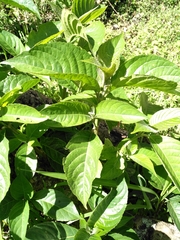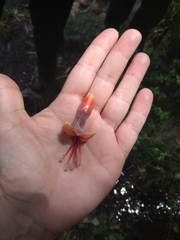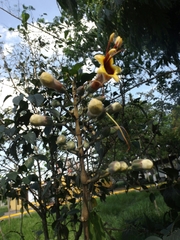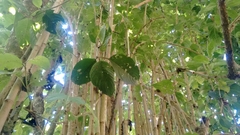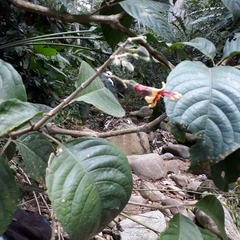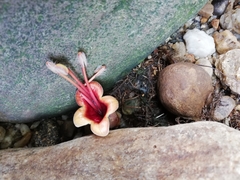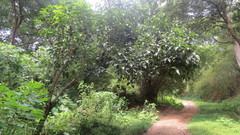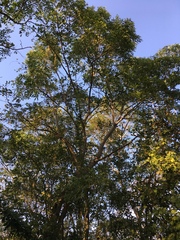
|
Family: Acanthaceae
|
Palo de agua, Asedera Small tree, usually to 10 (13) m tall; trunks slender, less than 15 cm dbh, often clustered and stilt-rooted, the leaf scars persisting; stems and branches quadrangular. Petioles to 6 cm long, the pairs often unequal; blades ovate to elliptic, acuminate, mostly obtuse to attenuate at base, mostly 11-20 (26) cm long, 4-10 (14) cm wide, glabrous except on veins of lower surface; cystoliths short, irregularly oriented, linear, obvious only when dry. Inflorescences terminal, compact, +/- secund panicles 5-15 cm long; branches to ca 6 cm long, densely tomentose, becoming scurfy in age; bracts triangular, ca 3 mm long; flowers +/- regular; calyx 7-10 mm long, deeply lobed, the lobes imbricate, rounded at apex, often tinged with purple; both calyx and corolla densely tomentose outside with both glandular and simple trichomes; corolla 3.5-4 cm long, glabrous and brick red inside, the tube to 3.5 cm long, glabrous near base, the limb 2-3 cm wide; stamens 4, exserted, in 2 pairs, the outermost of each pair slightly shorter, held to one side of tube, to 5 cm long; filaments fused at base in pairs, softly pubescent below with simple and glandular trichomes; anthers ca 6 mm long, introrse, marginally fringed; ovary ovate, sericeous, glabrous and nectariferous at base; style +/- equaling stamens, its upper lobe much reduced; nectaries not obvious. Capsules 1.5-2 cm long, 2-valved, obtuse, silky-pubescent; seeds 1-4 per capsule, flattened, lenticular, 3-4 mm broad. Croat 4632. 1. Trichanthera gigantea (Humb. & Bonpl.) Nees FIGURE 18 Ruellia gigantea Humb. & Bonpl. Pl. Aequin, 2. 75, pl. 102. 1800. Type col- lected along the Magdalena River, near Badilla, Colombia, by Humboldt and Bonpland. Type material in the Berlin Herbarium and Hooker Herbarium, Kew. Trichanthera gigantea Nees in DC. Prodr. 11: 218. 1847. Based on Ruellia gigantea Humb. & Bonpl. Shrubs or trees up to 5 meters high (sometimes bushy and bearing adventitious roots), the top rounded; branches quadrate, the angles rounded, the tips minutely brown-tomentose; lenticels prominent; leaf blades ovate to oblong, up to 26 cm. long and 14 cm. wide, acuminate at apex, narrowed at base, glabrous, or the costa and veins pubescent; petioles 1 to 5 cm. long; inflorescence a terminal compact more or less secund panicle 5 to 15 cm. long and 4 to 5 cm. broad, brown- tomentose; bracts triangular, 3 mm. long; calyx 10 to 12 mm. long, brown-tomentose, the segments 7 to 10 mm. long, 5 mm. wide, rounded at apex; corolla 3 to 4 cm. long, red and glabrous proximally, yel- lowish and silky-tomentose distally, red and glabrous within, the tube 1 to 1.5 cm. long, the limb 2 to 3 cm. broad, the lobes oblong to ob- long-ovate, 3 to 5 mm. wide; ovary tomentose; style 4 to 5 cm. long; capsule 1.5 to 2 cm. long, obtuse at apex, silky-pubescent, the hairs closely appressed; retinacula 3 mm. long, curved, truncate and erose at tip; mature seed 1 to 4 in each capsule, lenticular, 3 to 4 mm. broad, glabrous. VERNACULAR NAMES: Aro-blanco (Killip & Smith 15452); nacedero (Dryander 37); rompebarringa (Archer 523). Used in the vicinity of Fredonia, Antioquia, as a remedy for cattle (Archer 523). Under the impression that the species belonged to the genus Ruellia, Humboldt and Bonpland named it gigantea because of its contrast in size when compared with the other herbaceous or suffrutescent Ruellia. Forests, thickets, roadsides, and clearings, often in moist situations. Colombia, Venezuela, Panama, and Costa Rica. ANTIOQUIA: Vicinity of Fredonia, Archer 523 (US). Vicinity of Medellín, Toro 78 (NY). Titirib1, Archer 574 (US). Vicinity of Turbo, Haught 4549 (US). BOLÍVAR: Sahagún, Pennell 4101 (NY, US). San Martín de Loba, Lands of Loba, Curran 54 (GH, US). BOYACA: Vicinity of Boavita, Cuatrecasas 1924 (US). Moniquirá, Pérez- Arbeláez & Cuatrecasas 8132 (US). Crocó: Bahía Solano, near Ciudad Mutis, Killip & Garcia-Barriga 33589 (US). CUNDINAMARCA: Vicinity of Bogotá, Hermann 10926 (US). Caparrapi, Gar- ola-Barriga 7658 (US). El Colegio, Bro. Ariste Joseph 1061 (US). Road to Girardot between La Esperanza and San Javier, Garcia-Barriga 12193 (US); 12203 (US). La Mesa to Magdalena, Triana s. n. (NY, US). Hacienda Patasía, Pacho, Garcia-Barriga 12543 (US). Hacienda La Victoria on the San Bernardo Trail near Sasaima, Garcia-Barriga 12114 (US). EL CAUCA: Cali, Garcia-Barriga 4213 (US). El Tambo, von Sneidern 2652 (S); 2653 (8). EL VALLE: Vicinity of Cali, Pérez-Arbeláez & Cuatrecasas 6332 (US). El Freijito, Dryander 47 (US). La Manuelita, Palmira, Pennell & Killip 6193 (GH, NY, Ph). Hoya, between Quebradita del Retiro and Río Albán, Cuatrecasas 22631 (Ch). Timba, von Sneidern 1240 (NY, S). MAGDALENA (?): Poponte, Cyril Allen 876 (Mo). META: Villavicencio, Killip 34345 (US). NORTE DE SANTANDER: Trail between Chinacota and Esmeralda, Killip & Smith 20891 (US). Culagá Valley, north of Labateca, Killip & Smith, 20534 (NY, US). Rio Chitaga, regíon de Sarare, Cuatrecasas 13437 (US). Culagá Valley near Tapatá, Killip & Smith 20504 (NY, US). PUTUMAYO: Puerto Porvenir above Puerto Ospina on the Río Putumayo, Cuatre- casas 10733 (Col). SANTANDER: Bucaramanga, Killip & Smith 15452 (NY, US). Río Suratá Val- ley between El Jaboncillo and Suratá, Killip & Smith 16426 (US). TOLIMA: Ibagué, Holton (NY). WITHOUT LOCALITY: Lehmann 3010 (US). |
|
|
|





